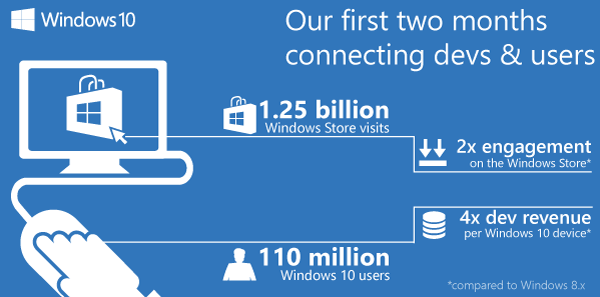With the launch of the unified Dev Center in April, we released the Windows and Windows Store trends page with much of the information we typically cover in this blog series. In an effort to provide you with new data to help you make even more informed decisions for all the apps you publish, we will focus this trends update on Windows 10.
Top Windows 10 trends:
- Windows 10 Adoption: Windows 10, released July 29 and currently available for Windows PCs and tablets, and now account for more than 50% of all Windows Store downloads. Developing apps for Windows 10 now sets you up to be in the Store when the first Windows 10 mobile users begin upgrading this fall.
- Windows Phone Update: Only notable changes for Windows Phone trends are highlighted here; see the Dev Center trends page for the full update.
- Downloads by Category: Games is still the dominant category, and this month we include a drill down on Game subcategories.
- Categories with Opportunity: Productivity has shot up to the number one category with opportunity for Windows 10 apps. An analysis of the opportunity within the Games subcategories is also shown.
- Downloads by Market and Language: Brazil continues to climb in the number of downloads as well as percentage of total downloads, while Brazilian Portuguese has jumped to the number three spot in downloads by language, and Turkish and Dutch enter the top ten languages for the first time.
Windows 10 Adoption Trends
The release of Windows 10 on July 29, 2015 also brought the release of the unified Windows Store, a single place to find apps for all Windows 10 devices. This unified Store combines all linked apps as well as universal apps into one listing, so users can purchase an app once and it will work on all compatible devices. Windows 10 is available for PCs and tablets at this time, and over 110 million devices are currently running the software. The mobile version will be released this fall, with a Windows Insider preview version available now. We’ve separated Windows Phone and Windows downloads to allow for a more accurate OS version comparison.
App download by Windows OS Worldwide, September 2015
 |
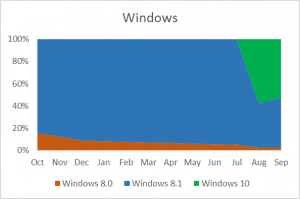 |
Windows 8.1 has been the most popular OS for both Windows and Windows Phone for the past year. However, Windows 10 is quickly establishing its presence in Windows Store traffic on PC and tablet (the green slice on the Windows chart).
In the few short months since release, Windows 10 users have made more than 1.25 billion visits to the Windows Store, and they account for more than half of the Windows Store downloads. For developers, Windows 10 translates into 2X the user engagement and 4X the revenue per user compared to Windows 8.x. Just as our large app partners are finding success on Windows 10, we believe it’s a good time to build and publishing a universal Windows 10 app – both to reach the growing audience on PC today, as well as the new Windows 10 devices coming this fall.
Windows Phone 8.x Store Update
This blog focuses on the trends we’re seeing in the Windows Store for Windows 10 apps, as the trends for the Windows Phone Store (and the Windows Store for 8.0 and 8.1) has not had any material changes and can be found on the Windows and Windows Store trends page. The majority of the trends are similar from past posts (April 2015, December 2014, September 2014). While we see some movement in the top five download categories, the actual percentage for each category has remained fairly stable. In-app purchases continue to make up the majority of sales in the Windows Phone Store, sales of paid apps are increasing and accounted for about 30% of sales in June 2015. Low-memory devices (under 1 GB) continue to account for the majority of Windows Phone users, and there are some new charts detailing user storage, screen size, and resolution that are worth considering as you develop apps in advance of the Windows 10 mobile release this fall.
Downloads Per Category
The Windows Store adjusted several of the app and game categories from the Windows and Windows Phones Stores, and introduced several new categories to allow more opportunities for app promotion. If you haven’t yet reviewed the new categories, take a look to ensure your app is in the most appropriate category.
The August 2015 download information provides the first insights with the new category structure. While Games is still the dominant category (see the graph below for more information), we see Entertainment, Photos & Video jump into the 2nd and 3rd spots for the first time, followed by Productivity and Utilities & Tools.
Windows 10 app downloads per category Worldwide, August 2015

August 2015 also provides a first look at which game subcategories are popular among Store customers. Action & Adventure games account for a quarter of all game downloads, followed by Puzzle & Trivia, Music, Racing & Flying, and Card & Board. Combined, these top five genres account for more than 70% of all game downloads. It’s important to note that while Word and Fighting appear on the bottom of the list, there are also very few apps in those categories.
Windows 10 app downloads per Games subcategory Worldwide, August 2015

Categories with Highest Incremental Download Opportunity
Understanding which categories have the highest ratio of downloads per app can also be helpful. This is a function of total downloads versus total available apps in that category. For example, while Games is the most-downloaded category, Productivity has more downloads per available app.
Index of average number of downloads per app in each category from Windows 10 devices Worldwide, August 2015
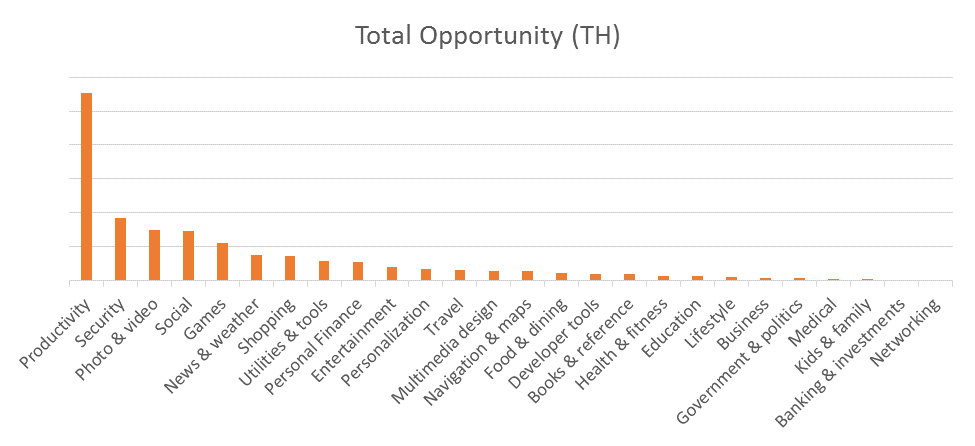
The categories have changed slightly from the Windows and Windows Phone Stores, but Games and Productivity are aligned with similar categories and remain in the top five, although we see Productivity with a huge jump to the number one spot. Photos & video is becoming an increasingly popular category, which is reflected in both downloads and opportunity. Security and Social remain in the top five, but we see Social fall from the number one spot to number four. If your goal is to reach the highest number of downloads possible, analyze these categories to understand which one presents the best potential for your apps.
The Games subcategory data also allows us to take a look at which subcategories have the most opportunity. Simulation and Racing & Flying are popular with customers, yet there are a limited number of apps available in each. As previously noted, the Word and Fighting subcategories have very few apps in them currently, which limit the number of downloads. There might be some opportunity in these subcategories even though they rank lower.
Index of average number of downloads per app in each Games subcategory from Windows 10 devices, Worldwide, August 2015

Downloads by Market
The Windows Store is currently available in 242 markets. As you build apps for Windows 10 and consider localization options outside your home market, examine these popular markets and which ones might be relevant to your app. We’ve shown the top 20 markets this quarter, so you can see which countries are early adopters of the new Windows Store. Countries falling into the “Other” category each account for less than 2% of Store downloads.
Index of average number of downloads per app by Windows 10 devices from Windows Store, by market Worldwide, August 2015
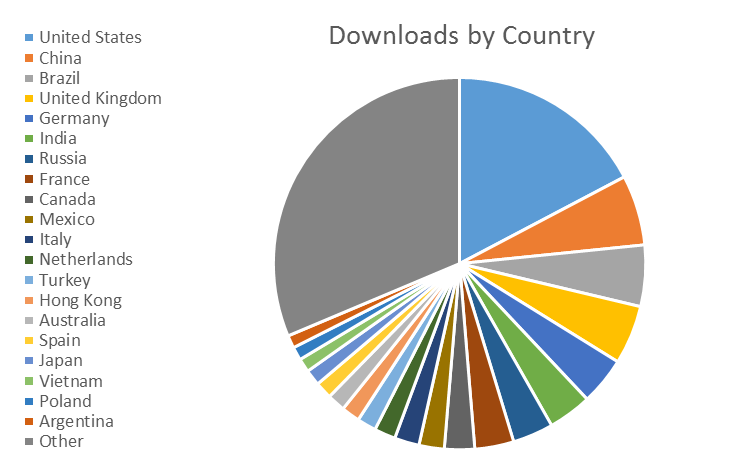
The United States is still the dominant market accounting for 17% of total downloads, and we see Brazil continues to climb in the rankings with over 5% market share. Other countries are also gaining significant share and should be strongly considered in your market selection.
Windows Store Customer Languages
Language is a key driver of downloads and adoption, and should be taken into consideration along with markets. For the first time, we see Dutch and Turkish enter into the top 10 languages, as Hindi and Cantonese fall out (note that we’ve increased the top languages shown to 12 this quarter). While the order has changed slightly on the other top languages, the actual percentage of their total downloads has remained fairly stable.
Primary language of Windows 10 customers in the Store Worldwide, August 2015
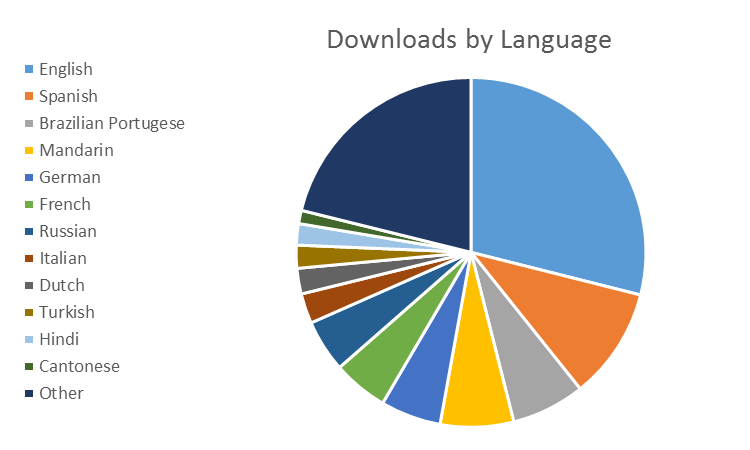
Monetization Options
As mentioned in the Windows 10 adoption trends section above, Windows 10 devices currently account for more than 50% of Windows Store downloads and generate more than 4x the revenue per device than Windows 8. To maximize your revenue, it’s important to consider which monetization model(s) will work best for your app and customers: paid apps, in-app purchase, or in-app advertising (showing ads in the app). The Windows and Windows Store trends page offers details on customer purchasing trends in paid and in-app purchases.
In-app advertising continues to be one of the most profitable areas of revenue for developers, and the video interstitial capabilities recently released by Microsoft Advertising can significantly increase your fill rate and eCPM. If your Windows Phone apps generate revenue from in-app advertising, we encourage you to implement the new Microsoft Universal Ad Client SDK, which is compatible with Windows 8.x and Windows Phone 8.x apps as well as apps built on the Universal Windows Platform, supports banner ads, video interstitial ads, and incorporates ad mediation (i.e. show ads from multiple ad networks, including third parties).
For Further Analysis
We recommend taking some time to browse through the app catalog in the categories you want to develop for, and analyze the top apps in each category to see what makes these apps successful based on the trends data provided.
If you haven’t already, we also encourage you to begin developing apps for Windows 10. The Windows 8.1 code is designed to easily transfer to Windows 10 apps, and by developing and publishing apps now you’ll be able to capture both PC customers in the Windows Store as well as the first mobile customers this fall. We also recommend registering for the Windows Insider Program to gain early access to app developer tools.
We hope this data helps inform your decisions on investment areas for new apps and app updates. Please share your ideas for other data that could help you make investment decisions as you plan for your next apps and games.

